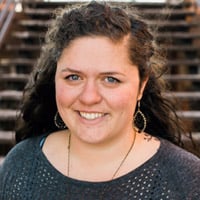If midwifery is one of the oldest professions in the world, why aren’t there more midwives? What do midwives do in addition to helping families give birth? How could midwifery solve problems we’re seeing in high maternal mortality rates and the healthcare labor shortage?
Those and other questions were addressed in a Grand Rounds session, “Midwives Making a Difference: How the Certified Midwife Credential Can Positively Impact the Women’s Health Workforce in Colorado,” Jan. 9 at the University of Colorado College of Nursing and streamed live on Zoom.
During the session, CU Nursing faculty Denise Smith, PhD, CNM; Shannon Pirrie, DNP, CNM; and Jessica Anderson, DNP, CNM, provided an overview about the role of midwives throughout history – while making a case for credentialing certified midwives (CM) just like certified nurse-midwives (CNM).
“Even though midwifery has most likely affected our lives in some way – if not directly, then through the lives of our ancestors – the practice has been scrutinized, questioned, and maligned over the years.”
– CU Nursing Assistant Professor Denise Smith, PhD, CNM
If you were unable to participate in Monday’s session, here are five of the most salient takeaways for those who are unfamiliar with the midwifery field:
-
Midwifery is one of the oldest professions in the world – Smith noted that accounts of midwives can be found in historical records dating back to 1600 B.C.

Denise Smith, PhD, CNM
“A textbook for midwives written during the Roman era has been passed down through the centuries,” Smith said. “Translations of this original text have been identified 900 years later in German, French, Chinese, and Japanese. This same text became the first textbook for midwifery written in the English language.”
Even though midwifery has most likely affected our lives in some way – if not directly, then through the lives of our ancestors – the practice has been scrutinized, questioned, and maligned over the years, Smith said.
An Assistant Professor and former Specialty Director for the Nurse-Midwifery Education Program at CU College of Nursing, Smith practices full-scope midwifery with the University Nurse Midwives, including teaching students in the clinical setting. -
Midwives provide a wide range of services and produce positive health outcomes – A substantial body of evidence from the U.S. and around the world supports that midwives are safe, effective, efficient, and provide patient-centered care.
“Studies show that midwives reduce cesarean birth, increase rates of breastfeeding, reduce the need for epidural anesthesia, and are associated with high rates of patient satisfaction,” Smith said.
Midwives attend births in various settings – including homes, birth centers, and hospitals. Both CMs and CNMs encompass a full range of primary healthcare services for women from adolescents through menopause. They provide primary care, gynecologic and family-planning services, preconception care before pregnancy, childbirth, and postpartum, and finally care of the newborn for the first 28 days of life.
Currently, there are 13,500 certified nurse midwives and certified midwives in America that attend approximately 10.3% of all births in the country. Though the number of midwifery-attended births has increased over the last 40 years, they still represent a small number of births overall. By comparison, 75% of births in Europe are attended by midwives. -
The midwifery field has experienced setbacks throughout history, but has observed a resurgence over the past 50 years – Early in the session, Smith raised a reasonable question: “If midwives are safe, why are there so few of us?”
She said that understanding of the history of midwifery in America is paramount to understanding the barriers to the profession.
“The acceptability of midwifery practices has waxed or waned – influenced by politics, religious dogma, and formalized medicine,” Smith said. “The choices of governments and society to professionalize and educate midwives correlates with the willingness of those in power to support the autonomy and rights of women.”
Smith said the limitation on midwifery practice in the U.S. is largely due to “early 20th century campaigns” to eliminate the practice of midwifery and to “do away” with midwives entirely. With industrialization came an exponential growth in the population centers of the East Coast – primarily through immigration. In the early 1900s, the U.S. had the highest infant mortality rates in recorded history.
“The public debates and conclusions made by the most influential voices at the time was that most midwives are women, and to educate and license them would mean they're enfranchised,” Smith said. “In addition, the physicians argued that if midwives continue to attend births, they’d take away from the future income prospects of the medical profession. That led to the increasing medicalization of birth. If anybody has studied birth in the 1940s and the 1950s in the United States, you're probably familiar with the concept of ‘twilight sleep’ and the overuse of forceps. There's a whole generation of women who can't recall the birth of their own children.”
Smith said a change began to take root in the 1960s and the 1970s as women gained more rights in society.
“They also reclaimed the rights to their bodies and their births,” she added.
That collective sense of autonomy led to grassroots efforts that resulted in organization and professionalization of midwives and the origin of the modern midwifery movement. -
Nurse-midwifery leaders in Colorado are leading the charge in getting CMs credentialed to practice in the state – Practice authority for CMs is only available in 11 states (mostly in the East Coast). Prescriptive authority is available on a more limited level in five other East Coast states and the District of Columbia.

Shannon Pirrie, DNP, CNM
During the session, Pirrie and Anderson explained why it makes sense for CMs to be credentialed to practice in Colorado just like CNMs. In essence, this policy shift would allow people to practice midwifery without being credentialed as a nurse first. Pirrie said the goal is to make midwifery education and midwifery services more accessible throughout the state.
As the Specialty Director of the Nurse-Midwife Program at CU Nursing, Pirrie pointed out in most states, the standards for education and certification for CNMs are identical to CMs.
Anderson, an associate professor and director of Midwifery Services at CU Nursing, said the effort to recognize CMs in Colorado is part of a national effort from the American College of Nurse-Midwives and other midwifery organizations nationwide.
“As of today, the CM credential does not exist in federal statute,” Anderson said. “One of the priorities from a national advocacy effort is to support [midwifery] education programs. This also could help certified midwives secure reimbursement [for medical services] from payers [such as health insurers].”
Midwifery organizations in Colorado are working with a lobbyist to draft legislation addressing the role of CMs. A bill is expected to be introduced in the Colorado Legislature this year. Anderson says that the political climate is favorable for the policy since nurse-midwives have proven their value in the state.
“We know that in the future, we are going to be lacking maternity care providers,” Anderson said. “From a professional stance, this is an opportunity that we need to actively address to support the growth of our profession.” When questioned after the session, Anderson said the ultimate goal would be to educate CMs if the bill passes.
Pirrie noted that a decent percentage of her students became credentialed as nurses because they wanted to be midwives. She said the existing state credentialing requirements could be detrimental to recruiting both nurses and midwives.
“In essence, [many aspiring CNMs] are sitting in seats that could be taken by other nursing students if they really just wanted to practice midwifery,” Pirrie said. -
Nurse-midwifery faces some significant workforce and equity challenges – Despite the resurgence of midwifery professionals throughout the country, the field faces some of the same issues with recruiting and retaining workers as other healthcare-related professions.

Jessica Anderson, DNP, CNM
A study from 2015 showed that 50% of Colorado CNM respondents were over the age of 50 and planning to retire or decrease their hours over time. Anderson said this data is another sound reason to support expanding the role of CMs in Colorado. According to U.S. Census data, Colorado’s population grew by 14.8% between 2010 and 2020. The state’s birth rate is 11 per 1,000 population – on par with the national average.
“This is an opportunity to actively address to support the growth of our profession,” Anderson said.
Anderson acknowledged that the profession has a long way to go in terms of diverse representation.
“In Colorado, we have around 7% of midwives of color compared to California, which has 22% midwives of color,” she said.
Recruiting more people of color to midwifery bridges equity gaps in the field while bringing in more CNMs and CMs to serve diverse communities throughout the state.
The Grand Rounds session was sponsored by the Office of the Dean at the CU College of Nursing and CU Nursing’s Office of Research and Scholarship.
A Comparison of CNMs and CMs
|
Credential |
CNMs |
CMs |
|
Minimum degree required |
Graduate Degree |
Graduate Degree |
|
Minimum Education Requirements for Admission to a Midwifery Education Program |
Bachelor’s Degree or higher from an accredited college and university. Must earn an RN license prior to or within a midwifery education program |
Bachelor’s Degree or higher from an accredited college and university. Must successfully complete required science and health courses and related health skills training prior to or within the midwifery education program |
|
Clinical Experience Requirements |
Attainment of knowledge, skills, and professional behaviors as identified by the American College of Nurse-Midwives Core Competencies for Basic Midwifery Education |
|
|
Range of Care Provided |
Midwifery as practiced by CNMs and CMs encompass a full range of primary healthcare services for women from adolescence beyond menopause. These services include the independent provision of pre-conception care, care during pregnancy, childbirth, and the postpartum period, care of the normal newborn during the first 28 days of life, primary care, gynecologic, and family-planning services. Midwifery care also includes health promotion, disease prevention, and individualized wellness, education, and counseling |
|
|
Practice Settings |
All settings: Hospitals, birth centers, and offices. The majority of CNMs and CMs attend births in hospitals |
|
Source: American College of Nurse-Midwives


